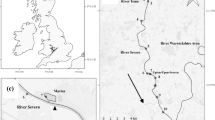Abstract
The spatial, diel and tidal variability in the abundance of piscivorous fishes and their teleost prey, and the dietary composition of predatory fishes were investigated in beds of Heterozostera tasmanica within Port Phillip Bay, Australia, from September 1997 to February 1998. Predatory and prey fish assemblages were sampled from beds of H. tasmanica at three locations during each combination of diel (day and night) and tidal (high and low) cycles. Pelagic and benthic crustaceans represented >60% by abundance of the diets of all predatory fishes. Seven species, 54% of all predatory fishes, were piscivorous. These piscivores consumed individuals from seven families, 36.8% of the fish families being associated with seagrass. Western Australian salmon, Arripis truttacea (Arripidae) (n = 174) and yank flathead, Platycephalus speculator (Platycephalidae) (n = 46) were the most abundant piscivores. A. truttacea consumed larval/post-larval atherinids, gobiids and sillaginids. P. speculator consumed late-juvenile/adult atherinids, clinids and gobiids. While the abundances of piscivores varied between locations (P < 0.001) and diel periods (P = 0.028), the relative differences in piscivore abundance between sites and diel periods were not consistent between tides. The abundances of A. truttacea varied in a complex way amongst sites, diel period and tidal cycle, as shown by a three-way interaction between these factors (P = 0.026). Only during diurnal periods at St. Leonards was the abundance of A. truttacea significantly higher during high than low tides (P < 0.001). During the other diel periods at each site, the abundance of A. truttacea did not vary. P. speculator was significantly more abundant nocturnally (P = 0.017). The abundance of small (prey) fishes varied significantly amongst sites (P < 0.001). During the day, the abundance of small fishes did not vary between high and low tides (P = 0.185), but their nocturnal abundance was greater during low tide (P < 0.001). Atherinids (n = 1732) and sillaginids (n = 1623) were the most abundant families of small fishes. Atherinids were significantly more abundant nocturnally (P = 0.005) and during low tides (P = 0.029), and varied significantly amongst sites (P < 0.001). Sillaginids varied significantly only amongst sites (P < 0.001). Seagrass beds provide a foraging habitat for a diverse assemblage of predatory fishes, many of which are piscivorous. Anti-predator behaviour and amongst-location variability in abundances of piscivorous fishes may explain some of the diel and tidal, and broad-scale spatial patterns in small-fish abundances.
Similar content being viewed by others
Author information
Authors and Affiliations
Additional information
Received: 23 July 1999 / Accepted: 18 January 2000
Rights and permissions
About this article
Cite this article
Hindell, J., Jenkins, G. & Keough, M. Variability in abundances of fishes associated with seagrass habitats in relation to diets of predatory fishes. Marine Biology 136, 725–737 (2000). https://doi.org/10.1007/s002270050732
Issue Date:
DOI: https://doi.org/10.1007/s002270050732




